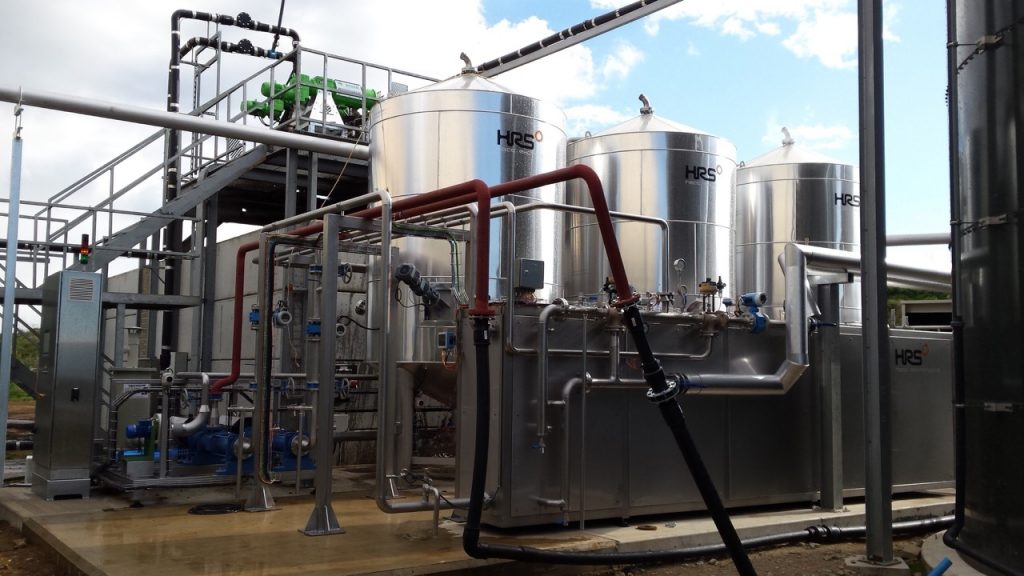
Efficient heat use can help cut agricultural emissions: white paper
February 27, 2019
By Matt Hale
Feb. 27, 2019 - Specific statistics for the use of heat in North American agriculture are hard to obtain. The U.S. Energy Information Administration (EIA) asserts that, ‘Energy for growing and harvesting crops is a large component of farm operating costs,’ while operations such as crop drying, livestock housing, water heating and greenhouse crop production consume considerable amounts of heat.
 An HRS Digestate Concentration System (DCS) installed at an anaerobic digestion plant on a Spanish farm. Heat is used to reduce the volume of digestate
An HRS Digestate Concentration System (DCS) installed at an anaerobic digestion plant on a Spanish farm. Heat is used to reduce the volume of digestate Agriculture may only account for 1.9 percent of total U.S. primary energy use, but in terms of global agricultural production, the total energy inputs are high. Although it is difficult to break down how America’s farming sector utilizes the 1,872 Btu of energy it consumes each year, some information is available from different sources. In 2016, natural gas and LPG combined accounted for 20 percent of agricultural energy2, much of which is likely to be used for heating. Echoing a trend that has been seen in other countries with modern agricultural systems, energy consumption for agriculture in the U.S. has become more energy intensive. Heat use varies widely both geographically and in terms of sector, with poultry and hog production, crop drying and protected horticulture being among the most heat-intensive sectors.
Decarbonizing heat on farms
Agricultural and horticultural businesses around the world have made great strides to reduce their greenhouse gas (GHG) emissions, but energy consumption by U.S. agriculture is rising. Heat has been one of the key targets for decarbonizing farming in many countries, and Europe in particular. According to the United Kingdom government, in 2015 the UK’s agricultural sector accounted for 10 per cent of total UK emissions, a fall of 17 percent since 1990. And at the forefront of decreasing agricultural GHGs in recent years is heat. CO2 emissions from agricultural and horticultural heating in the UK have fallen over the last decade, largely due to the adoption of biomass boilers, improved system efficiencies, and the rise of anaerobic digestion (AD) on farms.
For example, there are now more than 270 dedicated on-farm AD plants in the UK, converting slurries, manures and crops into biogas and biofertiliser. This biogas can then be converted into renewable electricity, biomethane gas or, of course, heat. An additional benefit of AD plants is that they also produce incidental heat, which can be captured and used within the AD process or for other on-site operations. There are multiple benefits to farmers of installing an AD plant; not least the opportunity to reduce direct and indirect GHG emissions through improved waste management and the generation of renewable energy. Maximizing the use of ‘green’ heat can bring even more rewards, helping to cut agricultural emissions and bring down on-farm heating costs.
Using heat exchangers
As shown above, there are many uses for heat on farms but getting this heat from one part of the process to another easily and quickly is essential if the benefits of this renewable heat are to be maximized and agricultural emissions curtailed. This is where heat exchangers come in. Heat exchangers take heat from one process or place and transfer it to another. In practice, they allow the heat from a liquid or gas to pass to another liquid or gas without the two having to come into direct contact. Common everyday examples include domestic radiators (which transfer heat from a boiler to a room) and car radiators (which take heat away from the engine).
Two of the most common types are Plate Heat Exchangers and Tubular Heat Exchangers. However, within these broad categories there are many different models and refinements and it is important to understand what is being offered. It is therefore advisable to consult a specialist who can explain the benefits of different types and perhaps offer different solutions. Whichever system is proposed, it is important to compare running costs, including maintenance and cleaning, over the full life of the plant – downtime caused by regular dismantling or cleaning can quickly eat into any capital savings made at the time of purchase.
Whatever the source of heat – biomass boiler, AD plant or other technology – efficiently transferring and using the generated heat is a vital part of making sure the overall system works as intended and keeping running costs to a minimum. Whether you are transferring boiler heat to a storage tank in a greenhouse, or taking the heat from a biomass boiler to the drying fans in a grain store, it is important that the right kind of heat exchanger has been specified and that it is suitably maintained. For example, Plate Heat Exchangers can easily become clogged with dust and dirt if not regularly cleaned, severely reducing their effectiveness and requiring more fuel and time to dry the same quantity of grain.
Any supplier of heat exchangers or heating systems should be happy to offer advice on the design or maintenance of new or replacement systems. The difference between an effective and efficient heat exchanger and an old or poorly maintained one can be striking, both in terms of running costs, as well as energy use and associated GHG emissions.
Matt Hale is the International Sales & Marketing Director for HRS Heat Exchangers.
Print this page